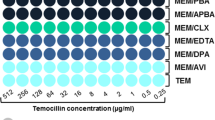Abstract
The in vitro susceptibility of 83Corynebacterium group D2 strains and 44Corynebacterium jeikeium strains to 12 antimicrobial agents was determined by an agar dilution technique using Mueller-Hinton agar supplemented with Tween 80 (0.025 %). All strains ofCorynebacterium group D2 were highly sensitive to fusidic acid, pristinamycin, teicoplanin and vancomycin (geometric mean MICs 0.047, 0.048, 0.338 and 0.396 mg/l respectively). Most of the strains were resistant to other antibiotics tested (ciprofloxacin, erythromycin, gentamicin, lincomycin, rifampin and tetracycline). However, a few strains were highly sensitive (MICs≤0.2 mg/l). The overall pattern of susceptibility of 44 strains ofCorynebacterium jeikeium was similar; the geometric mean MICs of fusidic acid, pristinamycin, vancomycin and teicoplanin were 0.234, 0.235, 0.557 and 0.652 mg/l respectively.
Similar content being viewed by others
References
Coyle MB, Hollis DG, Groman NB:Corynebacterium spp. and other coryneform organisms. In: Lennette EH, Balows A, Hausler WJ, Truant J (ed): Manual of clinical microbiology. American Society for Microbiology, Washington, DC, 1985, p. 193–204.
Soriano F, Ponte C, Santamaria M, Castilla C, Fernandez-Roblas R: In vitro and in vivo study of stone formation byCorynebacterium group D2 (Corynebacterium urealyticum). Journal of Clinical Microbiology 1986, 23: 691–694.
Soriano F, Ponte C, Santamaria M, Aguado JM, Wilhelmi I, Vela R, Cifuentes Delatte L:Corynebacterium group D2 as a cause of alkaline-encrusted cystitis: report of four cases and characterization of the organisms. Journal of Clinical Microbiology 1985, 21: 788–792.
Aguado JM, Ponte C, Soriano F: Bacteriuria with a multiply resistant species ofCorynebacterium (Corynebacterium group D2): an unnoticed cause of urinary tract infection. Journal of Infectious Diseases 1987, 156: 144–150.
Soriano F, Fernàndez-Roblas R: Infections caused by antibiotic-resistantCorynebacterium group D2. European Journal of Clinical Microbiology and Infectious Diseases 1988, 7: 337–341.
Riley PS, Hollis DG, Utter GB, Weaver RE, Baker CN: Characterization and identification of 95 diphtheroid (group JK) cultures isolated from clinical specimens. Journal of Clinical Microbiology 1979, 9: 418–424.
Jackman PJM, Pitcher DG, Pelczynska S, Borman P: Classification of corynebacteria associated with endocarditis (group JK) asCorynebacterium jeikeium sp. nov. Systematic and Applied Microbiology 1987, 9: 83–90.
Johnson WD, Kaye D: Serious infections caused by diphtheroids. Annals of the New York Academy of Sciences 1970, 174: 568–576.
Gill VS, Manning C, Lamson M, Woltering P, Pizzo PA: Antibiotic-resistant group JK bacteria in hospitals. Journal of Clinical Microbiology 1981, 13: 472–477.
Peloux Y, Garaix J, Brunet M: Les endocardites àCorynebacterium du groupe JK après chirurgie cardiaque. Presse Médicale 1983, 12: 766.
Finger H, Wirsing von Koenig CH, Wichmann S, Becker-Boost E, Drechsler HJ: Clinical significance of resistant corynebacteria group JK. Lancet 1983, i: 538.
Larson EL, McGinley KJ, Leyden JJ, Cooley ME, Talbot GH: Skin colonization with antibiotic-resistant (JK Group) and antibiotic-sensitive lipophilic diphtheroids in hospitalized and normal adults. Journal of Infectious Diseases 1986, 153: 701–706.
Allen KD, Green HT: Infections due to a “group JK”Corynebacterium. Journal of Infectious Diseases 1986, 13: 41–44.
Stamm WE, Tompkins LS, Wagner KF, Counts GW, Thomas ED, Meyers JD: Infection due toCorynebacterium species in marrow transplant patients. Annals of Internal Medicine 1979, 91: 167–173.
Riebel W, Frantz N, Adelstein D, Spagnuolo PJ:Corynebacterium JK: a cause of nosocomial device-related infection. Review of Infectious Diseases. 1986, 8: 42–49.
Soriano F, Ponte C, Santamaria M, Torres A, Fernandez-Roblas R: Susceptibility of urinary isolates ofCorynebacterium group D2 to fifteen antimicrobials and aceto-hydroxamic acid. Journal of Antimicrobial Chemotherapy 1987, 20: 349–355.
Santamaria M, Ponte C, Wilhelmi I, Soriano F: Antimicrobial susceptibility ofCorynebacterium group D2. Antimicrobial Agents and Chemotherapy 1985, 28: 845–846.
Fosse T, Carles D, Laffont C, Lefebvre JC, Boequet JP: Infections urinaire àCorynebacterium du groupe D2. Pathologie et Biologie 1988, 36: 742–745.
Marty N, Clave D, Cancet B, Henry-Ferry S, Didier J:Corynebacterium groupe D2: étude clinique, identification biochimique et sensibilité aux antibiotiques. Pathologie et Biologie 1988, 36: 460–464.
Arora MK, Robbins MJ, Holton J, Felmingham D: In vitro activity of the streptogramin group of antimicrobials againstCorynebacterium jeikeium and D2 coryneform bacteria. Journal of Antimicrobial Chemotherapy 1989, 23: 458–459.
Van Bosterhaut B, Claeys G, Gigi J, Wauters G: Isolation ofCorynebacterium group D2 from clinical specimens. European Journal of Clinical Microbiology and Infectious Diseases 1987, 6: 418–419.
Fernandez-Roblas R, Prieto S, Santamaria M, Ponte C, Soriano F: Activity of nine antimicrobial agents againstCorynebacterium group D2 strains isolated from clinical specimens and skin. Antimicrobial Agents and Chemotherapy 1987, 31: 821–822.
Chevalier J, Pommier MT, Crémieux A: Rôle du Tween-80 utilisé dans la culture des corynébactéries cutanées (groupe JK) sur la composition en acides gras cellulaires. Annales de l'Institut Pasteur/Microbiologie 1987, 138: 427–437.
Dealler SF: In vitro activity of L146032 daptomycin and other agents against JK diphtheroids. Journal of Antimicrobial Chemotherapy 1988, 21: 807–808.
Machka K, Balg M: In vitro activity of ciprofloxacin against group JK Corynebacteria. European Journal of Clinical Microbiology 1984, 3: 375.
Murphy PG, Ferguson WP:Corynebacterium jeikeium (group JK) resistance to ciprofloxacin emerging during therapy. Journal of Antimicrobial Chemotherapy 1987, 20: 922–923.
Author information
Authors and Affiliations
Rights and permissions
About this article
Cite this article
Philippon, A., Bimet, F. In vitro susceptibility ofCorynebacterium group D2 andCorynebacterium jeikeium to twelve antibiotics. Eur. J. Clin. Microbiol. Infect. Dis. 9, 892–895 (1990). https://doi.org/10.1007/BF01967505
Issue Date:
DOI: https://doi.org/10.1007/BF01967505



